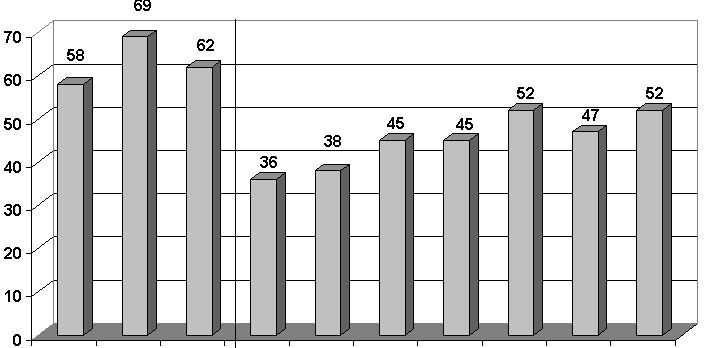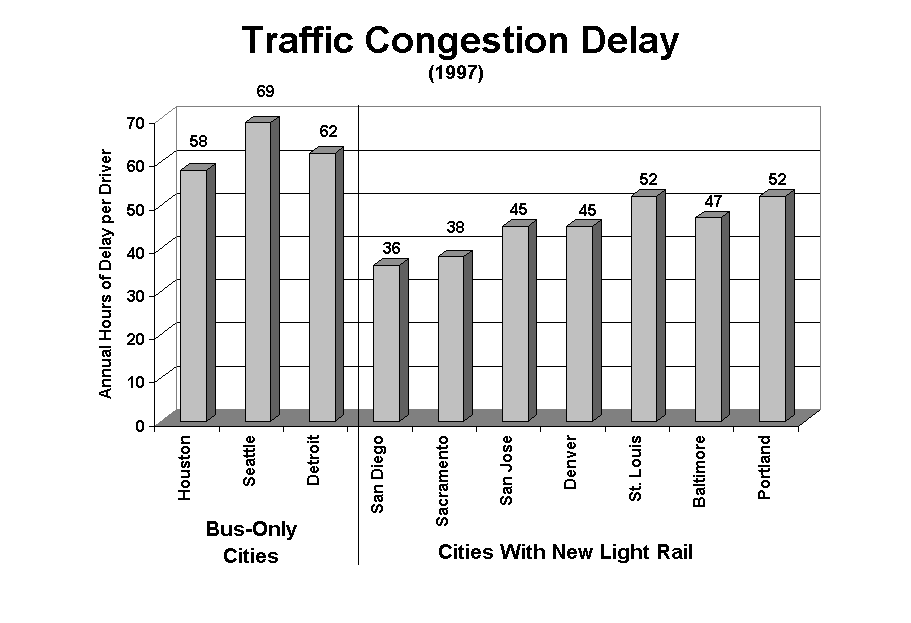
Light Rail Now and Walkable Neighborhoods (LRN) can be contacted at: Light Rail Now! |
Pro-automobile zealots like Wendell Cox, Thomas Rubin, the Texas Public Policy Foundation (TPPF), and others have repeatedly counterposed Houston as a model of a city where vigorous highway construction, reliance on buses alone, and the installation of HOV lanes have supposedly brought about a "reduction" in traffic congestion. While these rail transit opponents deny they use Houston as a model; and indeed, never say "Houston is our model", they consistently present Houston as an example of building highways and HOV lanes, with reliance on buses alone, to "reduce congestion" and supposedly solve problems. These allegations are then picked up, repeated, and widely disseminated by other rail opponents. Here are examples where Houston is presented as such a de facto model. • Rubin & Cox, in "Trolley Folly: A Critical Analysis of the Austin Light Rail Proposal", p. 5: "Only one urbanized area reported a decrease in traffic congestion – Houston – where the voters rejected light rail and the transit agency responded by implementing the largest busway/HOV lane system in the U.S." [Note: This distorts history; Houston voters initially voted for rail transit.] • Rubin & Cox, in "Options ignored, Opportunities Lost: An Analysis of Affordable Transportation Options for Austin" p. 5: "Alone among major Texas metropolitan areas, Austin does not have a belt or loop route (such as interstate 610 in Houston ....)" • Texas Public Policy Foundation, "Realistic Transportation Alternatives": "Houston and Phoenix have successfully reduced traffic congestion through expansion of their freeway systems, and are the only urbanized areas to have accomplished such a reduction between 1982 and 1996." [Note: This assertion is refuted below.] • Thomas Rubin and James E. Moore II, "Rubber Tire Transit: A Viable Alternative to Rail" (1997), p. 22: "Projects in Curitiba, Brazil; Orange County, California; Houston, Texas ... demonstrate that rubber-tire alternatives offer high levels of service more cost-effectively than rail transit options." Many of these documents are routinely disseminated by rail transit opponents nationwide. Many Light Rail Cities Have Lower Congestion Cox and Rubin, in particular, have sought to promote the Houston model as an example of traffic success in contrast to cities with light rail, which have supposedly been failures in solving traffic problems. But the truth is that, after decades of vigorous highway building, Houston actually has one of the highest congestion levels in the nation – certainly in Texas – and a variety of factual evidence demonstrates that Houston has certainly been no triumphant angel, vanquishing cities with light rail. While Cox, Rubin, and their cothinkers have been using it as a model, Houston's delights seem to wither on close examination. Cox and Rubin base much of their Houston case on a measure called the Roadway Congestion index (RCi), for which data are provided (through 1997) by the Texas Transportation institute. But despite its name, the Roadway Congestion index (RCi) is not a true measure of congestion. it's a measure of installed roadway capacity vs. traffic volume. Thus a city can have installed lots of suburban roadway capacity, show a good RCi, and yet have little impact on inner-city traffic where congestion is worst. But Cox and Rubin favor the RCI because it makes cities like Houston and Phoenix (which have installed excess capacity) look good in their "numbers voodoo". Measured in terms of real congestion – the annual hours of delay per driver – many cities with light rail systems actually have lower congestion than Houston and other cities which have relied only on highways and buses. it should be noted that 2 of the all-bus cities in the following comparison have been acclaimed for their innovative bus systems: • Houston – extensive system of HOV lanes • Seattle – HOV lanes, freeway bus stations, electric trolleybuses, and downtown bus subway  Source: Texas Transportation institute 1999 Annual Mobility Report Congestion Grows Faster in Houston Opponents of light rail – particularly Cox and Rubin – have claimed that Houston, supposedly alone in the nation, "reported a decrease in traffic congestion ...." They also claim that urban areas building or expanding light rail" experienced higher growth of traffic congestion than those areas without rail, such as Houston. But the chart below – using a reliable measure of congestion (the Travel Rate index) from the Texas Transportation institute – shows that a number of cities with light rail have experienced lower congestion growth than Houston (when measured since 1990, when several new light rail systems have come on line and have had time to develop ridership).  Source: Texas Transportation institute 1999 Annual Mobility Report Light Rail Progress Rev. 2001/01/25 |
|
|
|